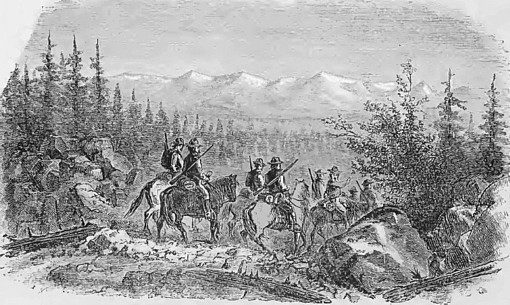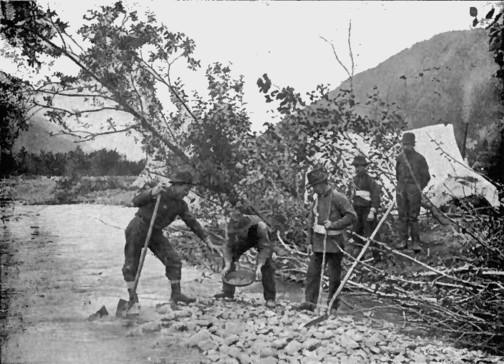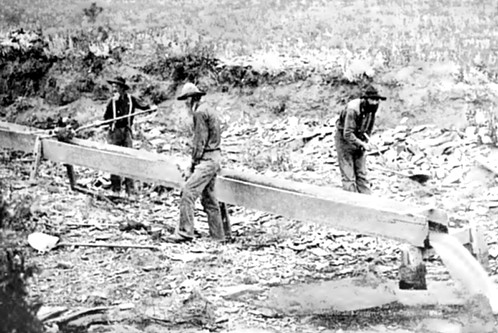The State of Colorado, situated on the eastern edge of the Rocky Mountains, abounds in mineral wealth, not only of precious metals like gold and silver, but also of iron, lead, coal, and others, insuring a future of remarkable prosperity. Gold mining, however, is now and for some time to come, must continue to be the chief interest of the Territory. The climate is remarkably healthy. The vast "Parks" as they are called, which are basins or plains in the midst of the mountains, demonstrate the fact that for wool growing, and stock raising, and for all agricultural products common to the latitude, the country will not be excelled by any of the Western States. All this is of importance in looking at the future of Colorado. The character of the Colorado gold mining differs from that of California, the former chiefly being what is called and known as "lode" mining, while the latter is principally "placer" mining. A typical Colorado "lode" is a quartz vein or fissure between walls of granite rock, extending from the surface to an indefinite depth and nearly perpendicular. On the surface they vary from a few inches to many feet in width. The method of mining is to sink a shaft in these quartz veins, (usually five by ten feet,) perpendicularly from the surface, raising the gold quartz and other mineral by steam or other power, to the surface. This is taken to the stamp mill where it is pulverized, and the gold separated by chemical action. At the surface and for some distance down, the gold deposits are mostly found mixed with quartz rock, but afterwards with iron pyrite and chalcopyrite, or other metals. Some of these veins contain immense wealth, and nearly all will yield sufficient to pay for working if faithfully and well managed. Where deposits of gold nuggets are found mixed only with the sands and alluvial washings of the mountains or hillsides, or in river beds, requiring chiefly the action of water to separate it, it is termed "placer mining." This class of mining can easily be prosecuted by individual miners. "Lode" mining can only be worked profitably by the aid of capital and powerful machinery, but experience has confirmed the belief that this kind of mining is the most profitable.
Below is a collection of 6 tales of adventure and history from Oregon's early gold mining days:
1. The Cripple Creek Gold Mines
Prove A World Wonder
2. The Cripple Creek Goldfields and Mines
3. The Early Gold Mining Days At Cripple Creek Colorado
4. Rich Days of Gold Mining in Cripple Creek Colorado
5. The Geology and Nature of
the Cripple Creek Gold Deposits
6. Cripple Creek Gold Mining Prospects
7. Early
Developments At the Cripple Creek Gold Mining Camp
8. The Cripple Creek Gold Rush as Described In Newspapers
9. The Richest, Most
Extensive Gold District in the West
10. Early Day Life In The Cripple Creek Gold Camp
11. The Hayden Gold Placer at Cripple Creek
12. Cripple Creek
Gold Ores and Geology
13. The Gold Mines of Cripple Creek Colorado
14. All About The Famous Cripple Creek Gold Mining Camp
15. The Cripple Creek Gold
Mines Strike Of 1894
16. The Cripple Creek Strike Of 19O3-4

The county and town of Gunnison were organized in 1876, but not until late in 1878, when prospectors fresh from Leadville and San Juan found rich silver and gold ores, and what they called carbonates, at the head of Quartz creek, near the present site of Pitkin, at the head of Tomichi river and in other localities, did the region attract the attention it deserved. In the spring of 1879 the grand gold rush influx began. Probably 20,000 men participated in the wonderful discoveries at Ruby Corner, Gothic, Crested Butte, Tin Cup, Killerton, Roaring Forks, and other camps. Fissure veins are here the characteristic deposit, and these are reinforced by vast beds of coal and iron. The most important towns and mining centers of the Gunnison country are Gunnison City, Ruby Camp, Pitkin, Gothic, Washington Gulch, Irwin, Crested Butte, Hillerton, Virginia City, Red Cliff, Tin Cup, Willard. Cochetopa and Aspen, Ruby Camp has its famous Forest Queen mine, and many others of scarcely less importance. Pitkin, on Quartz creek, is one of the most important silver camps in the State. Some idea of the distribution of ore minerals in the Gunnison country may be obtained from the following verbal chart: Ruby Camp, ruby Silver, stephanite and argentite silver sulfides; Washington Gulch, proustite, carbonates and argentiferous galena; Slate River, galena; East River, galena and tetrahedrite, copper ore; Copper Creek, native silver, ruby, sulphurets and gray copper: Maroon Creek, copper; Spring Creek, carbonates; Cement Creek, carbonates; Tin Cup Gulch, carbonates; Roaring Forks, galena and gray copper; Tumichi, galena; Union Park, gold; German Flats, gold; Anthracite Creek, anthracite coal; Coal Creek, iron ore and coal.
Silver Cliff and Rosita are situated in the Hardscrabble mining district, which has been made famous by the history of such mines as Bull-Domingo and Bassick. The discovery of true fissure veins in the neighborhood of Rosita antedates by five years any of the rich strikes that have made the Hardscrabble district so well known; and it is not at all surprising that this should be so. Silverton, the county seat of San Juan County and the great distributing point for the San Juan mines, is 250 miles from Pueblo and about forty miles from Durango. Silverton is supplied with water by three streams, Cement creek, Mineral creek and the Animas River. Over 1,000 people call Silverton home, and there is every indication of a steady increase for years to come. First, within a radius of two miles of Rico there were, open and paying, a large number of rich carbonate mines with ores high in silver. The Dolores Carbonate camp has been examined by many of the most eminent geologists and mining experts in this country, and we have yet to hear of one who has not given the most flattering reports of its extensive wealth and resources in cerrusite carbonate silver ore.
At intervals during the years which witnessed the building up of the young state of Colorado, occasional efforts were made to find out just what was hidden in the clefts and seams of the granite hills of the Cripple Creek region. The story of Bob Womack, "The Father of the Cripple Creek District" has often been told. As a young man on a cattle ranch owned jointly by himself and father, his spare moments were spent on the now famous hills of the great camp, prospecting for gold. He was laughed at and he was jeered but he did not care. He was convinced that wealth was hidden beneath the rock-ribbed hills for someone and he kept pegging away. At last he found it, but even Bob Womack did not dream of the future of the Cripple Creek district. He was generous to a fault and his generosity proved to be his downfall. He gave away mining claims and sold others for a song. Womack wandered over the hills, picking up bits of rock which his trained vision told him contained gold. Continuing in his tireless search, at last, in the fall of 1890, he found ore in place up in the region known as Poverty gulch, and he located the El Paso claim, now famous as the Gold King mine. With a sack full of rich specimens, he visited Colorado Springs, where he attracted the attention of E. M. De La Vergne and E. C. Frisbee, who visited the district in the winter of 1891. The result of their visit was the opening of the Gold King mine, from which the first shipment of ore was made in November, 1891. The opening of a pay mine stimulated prospecting, and success followed their efforts. They are the men who really opened and developed the mines of one of the greatest gold camps on earth. Discoveries quickly followed the Gold King, and later E. M. De La Vergne opened the Raven mine, on Raven hill, which now belongs to the Elkton Company. The year 1892 proved to be an important one, and two bonanza producers that have since attracted the attention of the civilized world were opened, the Portland and Stratton's Independence. The following spring, in 1893, saw the third great rush to the district, but this time the finds were genuine. Prospecting was started on all the hills, and, with quick succession, mines were opened and their development rapidly pushed. The Buena Vista, the Mary McKinney, Independence, Anaconda, Victor and Morning Star were among the first mines to become prominent. Before many months elapsed, all the hills of the district were covered with miners, the results of which the world knows. The district is famous for its rich tellurides calaverite and sylvanite in a fluorite gangue. Of course, the two previous mining excitements in the area caused many to be skeptical, which, to a great extent, kept men of capital out, so the district was developed by the tenderfoot. Work was carried on in a small way, as few had the necessary capital. However rich ore was found, and it paid the cost of mining as the work progressed, a condition that only few camps can boast of. When the first decade in the history of Cripple Creek was over, the mines were famous across the world, having produced the enormous sum of $121,286,990 in gold.


